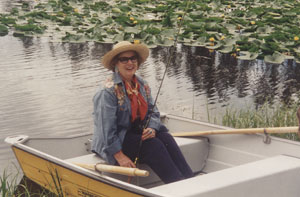Continuing to Travel
 Hi, I’m Esther Smith. If you are experiencing vision loss as I am, I hope you’ll find this column helpful.
I was diagnosed with macular degeneration over 18 years ago. At the time, my ophthalmologist told me that there was nothing I could do, and this news was devastating. For a time, I was in denial, and hid the fact that I had macular degeneration. But I realized that this was not the way I wanted to live my life, and I began to reinvent myself by exploring what I could do with my remaining vision, and what tools were out there to help me.
Hi, I’m Esther Smith. If you are experiencing vision loss as I am, I hope you’ll find this column helpful.
I was diagnosed with macular degeneration over 18 years ago. At the time, my ophthalmologist told me that there was nothing I could do, and this news was devastating. For a time, I was in denial, and hid the fact that I had macular degeneration. But I realized that this was not the way I wanted to live my life, and I began to reinvent myself by exploring what I could do with my remaining vision, and what tools were out there to help me.
 |
Here’s me fishing during a trip to Montana. |
Traveling
For my first column, I want to talk a little about traveling, something I enjoy greatly and had no intention of giving up. Over the years, I’ve found some routines that make getting through the airport and on to the fun easier and faster:- Don’t be embarrassed to ask for help when you need it.
- Be sure to identify yourself ahead of time as having a visual impairment.
- Memorize your identification numbers, charge card numbers, passport number, and bank number. Or you may want to set up a system to get to them easily should you lose your wallet.
- You can ask the airline to arrange for a human guide or set up a wheelchair to get to and from the plane easily and efficiently; a wheelchair especially helps at the security checkpoints, since you’ll avoid getting stuck in line.
- You may want to take your white cane for identification and should you decide to walk around the gate area or go to a restroom.
- You may want to ask for assistance when going through security lines to help you retrieve all your belongings after they go through the X-ray machine, especially small items placed in tubs.
- When you book your reservations, ask for the security guidelines and how much time you need to allow for clearing those requirements.
More about Esther Smith
Mrs. Smith has been involved in numerous volunteer activities in Dallas over the years, and is currently a member of the American Foundation for the Blind Center on Vision Loss Board. Esther’s Place, the 1800 square foot demonstration apartment at the Center, is named for Esther’s tireless work as the former head of the Center’s docent program. She was married for 47 years to Don Paul Smith, a noted inventor. Mrs. Smith is a graduate of Lindenwood College for Women in St. Charles, Missouri, and was a 2006 recipient of an honorary degree from the University of North Texas. In addition, she was head of the circulation department at the Fondren Library at Southern Methodist University for 11 years. Mrs. Smith has three daughters and seven grandchildren. For more about her experiences with macular degeneration, look for the APH Press book, Out of the Corner of My Eye, in which she shares more of her insights, and view the video Esther and Gwen: A Mother and Daughter Story.Listen to Esther Discussing Out of the Corner of My Eye